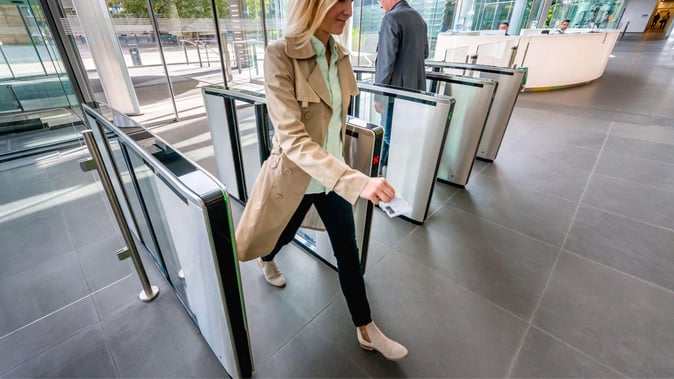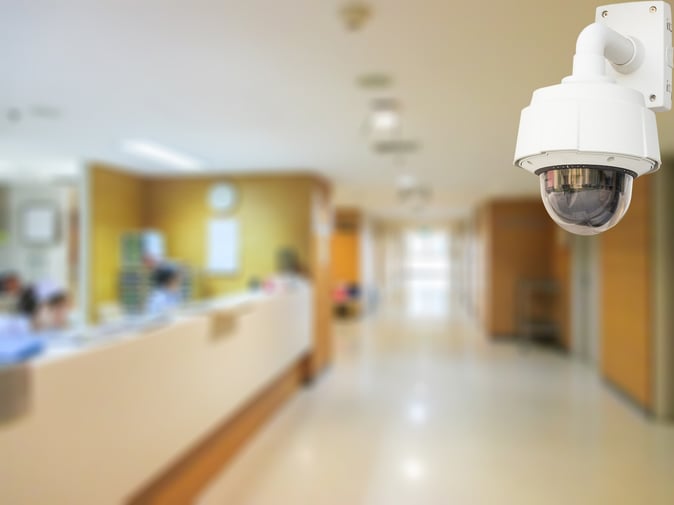Building usage is evolving. With buildings now accommodating multiple tenants and businesses, the need for stronger security measures has become increasingly apparent.
The reception or lobby area serves as the entrance to your building, floor, or zone, serving visitors and employees alike with a (hopefully) warm welcome. Footfall can be near-constant, making it a critical focal point for effective security. Without robust access control measures here, it’s impossible to regulate entry into your premises — which is bad news for security, but also for traffic flow and visitor experience.
So how, in the evolving landscapes of security and building usage, can you best secure this area? Let’s take a look at some practical tips for fortifying your reception, setting the scene for security throughout your premises.
1. Determine Your Security Needs
When it comes to securing your reception or lobby, you need to start by understanding your specific security needs. In today's world, businesses face a range of security risks, from active shooter events to terrorism and workplace violence.
Begin by evaluating the potential security risks your business may face. What have you dealt with before? What are you likely to deal with in the future? Is your business likely to become higher-risk? Spend some time brainstorming and then assess the severity and likelihood of these threats to determine the appropriate level of security. Here at Boon Edam, we tend to use the following levels:
- High security: prevention. If it’s likely (or even possible) that intruders will try to enter your premises, you may require more robust prevention measures that stop unauthorised people from ever entering your building.
- Medium security: detection. If you need to be alerted to potential security breaches but don’t necessarily foresee intrusion being a high risk, then you may need to implement detection measures.
- Low security: deterrence. Sometimes, all you need to do is monitor and control traffic. If your premises aren’t necessarily high risk but you want to manage footfall and deter intrusion, low security options may be just the thing you need.
1. Deploy the Right Entrance Security
Next, you’ll need to choose the right entrance security products based on your security needs.
For High Security
In environments where strict access control is required – like government buildings, data centres, or research facilities – security revolving doors or portals are ideal solutions. These advanced entrance products make tailgating and piggybacking impossible, only letting through one person at a time.
Products like our Tourlock 180 can detect both tailgating and piggybacking with StereoVision technology, while allowing for bi-directional traffic. This means that your premises can be kept secure without slowing down the flow into and out of the reception.
They can also be seamlessly integrated with access control technology for a truly secure entryway.
For Medium Security
If you’ve identified that your reception area only needs a medium security solution, then speed gates may be just right for you. Equally, you may choose to bolster a high-security portal door at the entrance with speed gates throughout your lobby to control traffic.
Speed gates like ours provide a strong visual deterrent to any unauthorised intruders and offer tailgating detection via intuitive sensors. You can also couple these with access control systems so that alarms are raised in real time if unauthorised entry occurs.
Less supervision is required, making speed gates perfect for lower-risk, multi-use buildings that still need to manage visitors and stay secure.

For Low Security
In instances where access control is not a primary concern but you still want to maintain crowd control and monitor traffic, physical barriers like turnstiles or access gates are ideal.
Solutions like our Winglock Swing are stylish and intuitive, with intelligent LED lights guiding an easy and clear passage while making for a visible deterrent for intruders.
Keep in mind that supervision is still required here, and the level will vary depending on whether you choose to integrate access control or not.
3. Integrate Access Control
When integrated into physical security entrances or gates, access control systems create a highly secure solution for granting access and mitigating unauthorised entry. Implementing an access control system means that you can effectively manage access to specific areas within your premises, including your reception or lobby area.
They’re typically made up of:
- Access control devices like cards and card readers. Access cards serve as credentials for authorised users, and card readers grant (or deny) access based on the information stored within each card.
- Access management dashboard. This acts as the central control hub for your access control system. Administrators can use an interface like the BoonTouch to manage access control settings, grant and revoke access, as well as report on and monitor system activity.
- Hardware components like control panels and servers which act as the backbones of your access control system.
While an access control system helps protect your lobby or reception, it doesn’t stop there — you can set different access levels for different personnel throughout your building or floor. For example, you may choose to allow all personnel into the lobby area, but only the C-suite is allowed to access the boardroom.
If you need even higher security, opt for biometric access control. A card can, in theory, be stolen, but biometric identification offers a foolproof way to prevent unauthorised access via your reception.
4. Install CCTV & Alarm Systems
In addition to physical access control measures, integrating CCTV cameras and alarm systems will further strengthen the security of your reception or lobby area.
Cameras provide continuous surveillance, capturing video footage that can be monitored in real-time or reviewed. Using cameras in conjunction with access control systems puts security well and truly in your hands – for example, you can check the CCTV system if your access control system notifies you that an unauthorised access has occurred.
Like many security solutions, CCTV and alarm systems can also effectively deter potential threats. Alarms can either be triggered manually when a threat is spotted or automatically based on defined triggers – like motion detection out of hours.
When selecting a CCTV and alarm system, make sure you know what you need:
- How long do you need CCTV footage to be stored for?
- What areas are the potential hotspots and, therefore, how many cameras do you need?
- Do you need motion detection alarms and, if so, during what hours of the day or night should they be armed?
- Do you require remote monitoring and where?
If the only possible entrance to your premises is via your reception (common in multi-use buildings), then you might find you only need one or two cameras. But if there are multiple weak spots and you need continuous surveillance on your premises, more will be necessary — we’d advise having a consultation with a trusted provider.

5. Protect Your Reception at Night
While it’s often easiest for intruders to enter your premises during the day when the reception is bustling with traffic, they may also feel emboldened when it gets dark.
The first – and easiest – way to help mitigate this is via the use of strategically-placed lighting. You may choose to have a policy to leave on lobby lights during the night, or to set up motion-activated lighting that saves on energy.
Another way to protect your reception from dusk until dawn is by opting for security door providers that offer burglar protection packages. Here at Boon Edam, our Burglary Protection Package is compatible with a range of our doors and ensures that your chosen solutions are tested to withstand burglary attempts.
If the entrance to your reception is an integral part of your security system and you need a high degree of burglary protection, the advanced shield security doors offer the best protection. Not only can they be remotely controlled, but you can automate them to switch between day, night, and secured operating modes.
There’s also an instant lockdown feature should you need to immediately shut down access to your premises in the event of an imminent threat.
6. Increase Staff Awareness
Beyond physical barriers and technological solutions, a key means of securing your reception area is through increasing staff awareness. Users of your reception and beyond should feel empowered to identify and respond to potential security threats. Here are some of the ways you can achieve this:
- Staff training on your security solutions. Employees and building users should be educated on the benefits and uses of your security doors, gates, and access control systems.
- Highlight the importance of sign-in procedures. Building users need to be aware of just how crucial visitor sign-in procedures are and that their ID cards or codes are not to be shared.
- Empower staff to act if they’re uncertain. It’s all too easy to second-guess yourself in the face of a potential threat – but staff must be made aware that questioning something in the name of security is never silly. Unfamiliar faces can and should be challenged.
- Establish clear security procedures. It’s important that security policies and processes are communicated clearly (and regularly) to building users. Establish incident procedures for each area — for example, what is the difference in response if an incident happens in your reception vs if one happens in the boardroom?
A Comprehensive Security Framework is Key
Since COVID-19 first hit, we’ve seen a dramatic increase in multi-use buildings. Buildings that were formerly owned or occupied by just one tenant are now home to multiple tenants and businesses. From office space and retail to accommodation and leisure, it is becoming much more common to see buildings used for more than one purpose.
As a result, ‘entrance’ control is no longer restricted to the entrance. Your reception might be, say, on the fifth floor of an otherwise poorly-secured building. Or, you might have a reception on the first floor but your main premises is on the third floor – so all visitors need to be sent up.
With all this in mind, it’s easy to see why security frameworks need to be comprehensive and holistic. It’s often not enough to have a single security door at your entrance, but instead it’s vital to pull security systems throughout your premises. Extend your security from the lobby into various parts of a building by integrating biometric or key-card access control systems in conjunction with speed gates, access gates, and security doors.
A few well-placed, strategically-chosen, high-quality security products can fortify your reception area and beyond.
With Boon Edam, complex security technology doesn’t need to be complicated. We make reception and lobby security simple and effective – but more than that, we can make it holistic. Give us a call if you’d like to find out more about how we can help secure your premises.

.jpg)